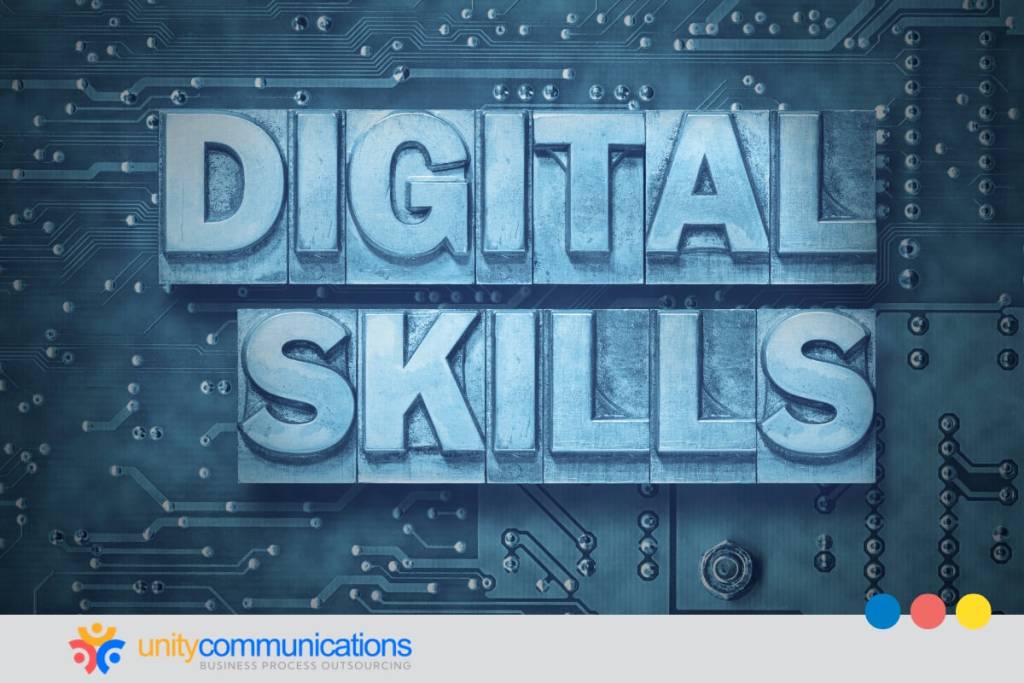Table of Contents
How can your in-house team keep pace with rapid digital change without overwhelming internal resources? Business process outsourcing (BPO) offers a strategic solution by providing scalable, expert-led training programs.
By improving digital skills through outsourcing, organizations can enhance productivity, accelerate technology adoption, and align workforce capabilities with evolving business objectives.
This article delves into how outsourcing digital training can build a digitally fluent team that thrives in today’s competitive landscape.
Why digital skills development is critical for modern teams

Digital fluency is no longer optional for teams managing automation, platforms, and data. It now shapes how people collaborate, problem-solve, and deliver. Without it, workforce productivity stalls or declines.
Upskilling has become a non-negotiable. According to the National Skills Coalition, 92% of jobs now require digital capabilities, yet roughly one-third of workers lack basic digital proficiency. This mismatch signals a deep skills gap that can hold back teams and slow down digital transformation.
To progress, human resources (HR) and learning and development (L&D) leaders must close this divide by targeting foundational and advanced proficiencies to support remote collaboration and data literacy. They are now essential for any house team driving change. Digital skills training directly drives business goals by:
- Boosting performance with existing technology tools
- Accelerating the adoption of new systems across departments
- Improving decision-making through better data literacy and communication
Many now explore external options to move faster and address gaps without overloading internal teams. One path gaining traction is improving digital skills through outsourcing.
How outsourcing enhances digital training programs
What is BPO, and how does it aid internal digital efforts? Outsourcing gives in-house L&D programs the structure, speed, and scale they can’t always manage alone. It supports urgent training needs without draining internal bandwidth.
The market reflects the shift. The average training outsourcing spending reached over $322,000 in 2023, up from $197,000 in 2022. Instead of replacing internal programs, outsourcing digital solutions complements them. It fills skill gaps, handles technical modules, and frees internal teams to focus on culture-fit training. This growth stems from key advantages:
- Proven expertise. Specialists bring frameworks designed for adult digital learning.
- Rapid scaling. External partners deploy programs quickly across regions and departments.
- Fresh content. Third-party BPO providers maintain current materials without internal strain.
This mix of speed and precision makes improving digital skills through outsourcing a practical move for teams under pressure to upskill quickly.
Accessing digital expertise quickly through outsourcing
Speed matters when digital gaps stall project rollouts or stall software adoption. Service providers help teams move quickly by supplying ready-to-go specialists. It’s a fast lane to improving digital skills through outsourcing without hiring delays.
The benefit is widespread. A 2024 Deloitte Global Outsourcing Survey found that 96% of organizations turn to external providers to tap into new talent streams. This signals high confidence in BPO providers as a fast, strategic workforce extension.
With urgent digital needs, internal teams need access without wait times or resource bottlenecks. Outsourcing eliminates common bottlenecks:
- Provide instant access to upskilling talent in coding, automation, or data.
- Cut hiring cycles by weeks or months through pre-vetted professionals.
- Cover time zone gaps with global 24/7 support models.
- Boost team capability without adding full-time headcount.
This approach supports rapid deployment, cost savings, and high-impact instruction, especially when your internal team can’t scale fast enough.
Building comprehensive digital skills through vendors
BPO vendors support structured growth, from basic software use to advanced analysis, aligning training with daily team demands. That’s how improving digital skills through outsourcing becomes a long–term growth engine.
Most internal teams lack the bandwidth to teach foundations and deep skills. Outsourcing digital capability-building lets your business move in both directions, broadening access and deepening expertise. BPO training programs typically cover:
- Foundational: cloud computing, office software, secure password practices, mobile security
- Intermediate: customer relationship management (CRM) workflows, collaboration tools, and digital communication protocols
- Advanced: data visualization, workflow automation, application programming interfaces, and artificial intelligence (AI) tools
External specialists build layered curricula that keep up with platform updates and employee roles. The result is a pipeline of job-ready learners growing alongside their tools.
This dual-track model helps departments boost results cost–effectively while extending programs across functions. That’s where outsourcing digital development scales beyond one-off training to real team capability.
Accelerating learning through project-based training

External providers embed learning into real workflows rather than relying on theory-based instruction. This practical approach helps staff immediately apply new skills to tools and scenarios.
Project-based training accelerates learning because it matches natural learning patterns. BPO organizations guide employees to practice tools in context, transforming abstract concepts into performance-ready skills. Effective programs include:
- Simulated projects using actual company workflows
- Sandbox environments that allow trial and error without real risk
- Live coaching through sprint cycles
- Cross-functional exercises that reflect interdepartmental collaboration
- Real-time feedback on tool usage, learning pace, and application results
- Skill reinforcement through repetition in structured settings
Project-based training transforms abstract concepts into performance-ready skills by embedding learning directly into real workflows, using simulated environments and live coaching to accelerate skill development through natural, contextual practice.
Aligning outsourced training with business goals
With generative AI expected to automate up to 30% of current work hours by 2030, rapid reskilling becomes essential for staying competitive. Outsourcing provides the speed and specialization needed to bridge skill gaps efficiently.
External providers deliver tailored solutions supporting foundational and specialized skills, enabling your team to focus on strategic development priorities. Align outsourced training with business goals:
- Customizable digital training pathways for specific departmental needs
- Scalable solutions that support multiple teams simultaneously
- Access to industry-leading experts with up-to-date knowledge and proven digital teaching methods
- Measurable progress that directly ties learning outcomes to performance metrics
Instead of relying solely on internal resources, external vendors provide scalable and up-to-date programs that align closely with company objectives.
Leveraging advanced training technology through partners
Outsourcing partners provide immediate access to cutting-edge training platforms without the complexity of technology selection and implementation. Access to better tools supports improving digital skills through outsourcing while removing tech selection hurdles.
These curated solutions integrate seamlessly with existing workflows, delivering faster deployment and better learning outcomes. Here’s how outsourced tech elevates training:
- Access to AI-powered learning systems with adaptive course suggestions
- Built-in mobile access to support deskless and hybrid teams
- Cloud-based platforms that enable real-time tracking and collaboration
- Integration-ready APIs that sync with internal HR and learning management system (LMS) tools
- Advanced video coaching, simulations, interactive walkthroughs, and gamified skill challenges
- On-demand libraries are updated frequently by subject-matter experts
These external solutions keep tech current without draining internal information technology (IT) teams. BPO enterprises handle maintenance, upgrades, and security while enabling effective learning at scale.
Scaling digital upskilling through flexible outsourcing models
Rapid technology changes demand adaptable training approaches. Outsourcing providers offer modular, scalable programs that adjust to business needs rather than fixed headcount constraints.
This flexibility enables quick responses to workforce gaps or product rollouts without rebuilding entire training systems. Here’s how these models support scalability and speed:
- Tiered service options that scale from small teams to global departments
- Pay-as-you-grow pricing to match business cycles or seasonal needs
- Multilingual trainers to reach distributed workforces efficiently
- Microlearning modules that work across roles and schedules
- Dedicated account teams that adjust delivery as priorities shift
- Skill-specific bootcamps for fast deployment during tech adoption
This structure allows your company to train without locking into rigid schedules. It keeps learning agile and relevant while removing constraints that often stall internal upskilling plans.
Measuring success in outsourced training programs

Tracking training results is non-negotiable. For HR and L&D teams, improving digital skills through outsourcing means accessing measurable progress tools, not just content delivery.
Outsourced programs typically come with built-in analytics. These systems go beyond completion rates to reveal how well users absorb, apply, and retain digital skills in real time. Here’s how progress is measured effectively:
- Pre- and post-training assessments to benchmark skill improvements
- Skill mapping dashboards tied to job roles or digital maturity levels
- Usage data for course interactions, drop-off points, and replays
- Performance simulations that track real-time task execution
- Managerial review portals with learner-specific performance data
- Certification outcomes tied to specific platform or software expertise
- Automated alerts for stalled learners needing extra coaching support
- Quarterly reports linking training outcomes to business impact metrics
These metrics help you spot weak areas, course-correct quickly, and link learning directly to business outcomes. The transparency can also justify L&D spending while building better programs over time.
Building long-term digital training partnerships
For many, building digital capabilities with external partners becomes a pillar of their broader workforce strategy, particularly when tech and roles shift constantly. Long-term vendor partnerships help standardize the delivery and tracking of training.
Rather than treating upskilling as a project, organizations build continuous development paths that evolve with their needs. Here’s how strategic integration works over time:
- Multi-year business process outsourcing agreements that include periodic program reviews and updates
- Training roadmaps mapped to digital transformation or platform rollouts
- Alignment with workforce planning to address future skills demand
- Embedded trainers who support internal teams during scaling phases
- Ongoing audits of learning content to keep pace with tool changes
- Cross-department training models that promote shared digital fluency
- Feedback loops between vendors and in-house training lead
This consistency gives you a reliable growth path and reduces reliance on stopgap fixes. Outsourced digital learning becomes an operational advantage, not just an L&D function.
The bottom line
Modern teams need fast, relevant, and scalable training. Outsourcing delivers all three by embedding expert-led instruction directly into workflows while reducing the load on internal teams. With the right partner, outsourcing digital skills training becomes a cost-effective, future-ready strategy that drives capability and performance.
Ready to build a digitally fluent workforce? Let’s connect and explore how strategic training partnerships can accelerate your team’s success.




